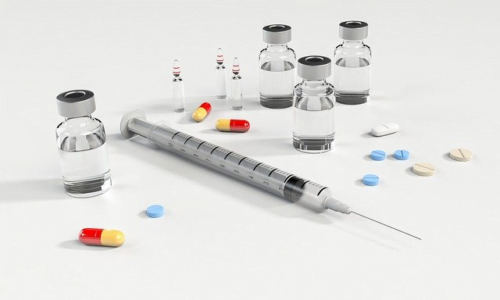Scheduled drugs’ list
Context:
Bombay High Court has asked the Centre to include Remdesivir in the list of scheduled drugs and to regulate its pricing.
The direction came while the Bench was hearing a suo motu public interest litigation (PIL) petition on the shortage of oxygen, non-availablity of Remdesivir, Tocilizumab injections, and hospital beds in Nagpur district.
Other measures suggested by the Court:
The court also said that it is possible to regulate the pricing if a liberal interpretation is given to the provisions of Drugs and Cosmetics Act (DCA).
- The provisions of the DCA allow restriction or regulation of prices of a drug that was essential during a natural calamity or epidemic.
- Both the Drugs Control Act and DCA enable the central government to issue a notification to fix rates of essential drugs during an epidemic.
What are the Schedules Drug and Cosmetic Act, 1940 & Rules 1945?
Schedules are the set of provisions for classifications of drugs, forms, fees, standards, requirements and regulations related to drugs and cosmetics under Drug and Cosmetic Act, 1940 and Rules, 1945. Here drugs includes pharmaceutical, Ayurvedic (including siddha), unani and tibb system of medicines, homeopathy etc.
Schedules are divided alphabetically and named also alphabetically like Schedule A, Schedule B etc till Schedule Y. Schedule Z is proposed but not implemented yet. Schedules are important part of Drug and Cosmetic Act 1940 & Rules, 1945. Every schedule contains specific information as discussed below.
Schedule A: Schedule A describes application forms and licenses types.
Schedule B: Schedule B describes Fees for test or analysis by the Central Drugs Laboratories or State Drugs Laboratories
Schedule B1: Schedule B1 describes fees for the test or analysis by the Pharmacopoeial Laboratory for Indian Medicine (PLIM) or the government analyst (PHARMACOPOEIA COMMISSION FOR INDIAN MEDICINE & HOMOEOPATHY)
The Union Cabinet has recently given its approval to re-establish Pharmacopoeia Commission for Indian Medicine & Homoeopathy (PCIM&H) as Subordinate Office under Ministry of AYUSH. PCIM&H is to be merged with the two central laboratories: Pharmacopoeia Laboratory for Indian Medicine (PLIM) and Homoeopathic Pharmacopoeia Laboratory (HPL). The two laboratories were established in Ghaziabad in 1975. At present, PCIM&H is an autonomous body under AYUSH ministry.
Schedule C: Schedule C describes the Biological and Special Products
Schedule C(1): Schedule C(1) describes the Other Special Products
Schedule D: Schedule D describes the import requirements
Schedule D(1): Schedule D(1) describes the Information and undertaking required to be submitted by the manufacturer or his authorized agent with the Application Form for a Registration Certificate. The format shall be properly filled in for each application in Form 40. The detailed information, secret in nature, may be furnished on a Computer Floppy
Schedule D(2): Schedule D(2) describes the Information required to be submitted by the manufacturer or his authorized agent with the Application Form for the registration of a bulk drug/formulation/special product for its import into India. The format shall be properly filled in and the detailed information, secret in nature, may be furnished on a Computer Floppy
Schedule D(3): Schedule D(3) describes the information and undertaking required to be submitted by the manufacturer or his authorised importer/distributor/agent with the application form for a registration certificate
Schedule E(1): Schedule E1 describes the List of poisonous substances under the Ayurvedic (including Siddha) and Unani Systems of Medicine
Schedule F: Schedule F part I to Part XIIA were omitted. Part XII B describes the requirements for the functioning and operation of a blood bank and / or for preparation of blood components. part XII D describes the requirements for collection, processing, testing, storage, banking and release of umbilical cord blood derived stem cells.
Schedule F1: Schedule F1 is divided into parts. Part 1 describes about vaccines. Part 2 describes the antisera. Part 3- Diagnostic antigens which describes the Provisions Applicable to the Manufacture and Standardization of Diagnostic Agents (Bacterial Origin) . Part 4 – General
Schedule F2: Schedule F2 describes the standards for surgical dressings.
Schedule F3: Schedule F3 describes the standards for umbilical tapes.
Schedule FF: Schedule FF describes the Standards for ophthalmic preparations.
Schedule G: Schedule G describes the list of drugs which are mostly in hormonal in nature
Schedule H: Schedule H describes the drugs which can be sold out in retail against prescription of registered medical practitioner only i.e. prescription drugs
Schedule H1: Schedule H1 describes the drugs which can be sold out in retail against prescription of registered medical practitioner only. This schedule contains mostly antibiotics and habit forming drugs.
Schedule I: Schedule I has been omitted.
Schedule J: Schedule J describes the diseases and ailments (by whatever name described) which a drug may not purport to prevent or cure or make claims to prevent or cure.
Schedule K: Schedule K describes the class of drugs and extent & condition of exemption from provisions of Drug and Cosmetic Act, 1940 & Rules 1945.
Schedule L and L1: Schedule L has been omitted and Schedule L1 describes the good laboratory practices and requirements of premises and equipments
Schedule M: Schedule M describes the good manufacturing practices and requirements of premises, plant and equipment for pharmaceutical products.
Part 1: Good manufacturing practices for premises and materials
Part 1A: Specific requirements for manufacture of sterile products, parenteral preparations (small volume injectables and large volume parenterals) and sterile ophthalmic preparations.
Part 1B: Specific requirements for manufacture of oral solid dosage forms (tablets and capsules)
Part 1C: Specific requirements for manufacture of oral liquids (syrups, elixirs, emulsions and suspensions)
Part 1D: Specific requirements for manufacture of topical products , i.e. external preparations (creams, ointments, pastes, emulsions, lotions, solutions, dusting powders and identical products)
Part 1E: Specific requirements for manufacture of metered-dose-inhalers (mdi)
Part 1F: Specific requirements of premises, plant and materials for manufacture of active pharmaceutial ingredients (bulk drugs)
Part 2: Requirements of plant and equipment
Schedule M-1: Schedule M1 describes the good manufacturing practices and requirements of premises, plant and equipment for homoeopathic medicines
Schedule M-2: Schedule M2 describes the requirements of factory premises for manufacture of cosmetics
Schedule M-3: Schedule M3 describes the quality management system –for notified medical devices and in-vitro diagnostics
Schedule N: Schedule N describes the list of minimum equipment for the efficient running of a pharmacy
Schedule O: Schedule O describes the standard for disinfectant fluids
Part 1: Provision applicable to black fluids and white fluids
Part 2: Provisions applicable to other disinfectant fluids
Schedule P: Schedule P describes the life period of drugs
Schedule P1: Schedule P1 describes the pack size of drugs
Schedule Q: Schedule Q describes the list of dye, colour and pigments
Part 1: List of dyes, colours and pigments permitted to be used in cosmetics and soaps
Part 2: List of colours permitted to be used in soaps
Schedule R: Schedule R describes the standards for condoms made of rubber latex intended for single use and other mechanical contraceptives
Schedule R1: Schedule R1 describes the Indian Standards laid down from time to time by the Bureau of Indian Standards for medical devices.
Schedule S: Schedule S describes the standards for Cosmetics Standards laid down from time to time by the Bureau of Indian Standards
Schedule T: Schedule T describes the good manufacturing practices for ayurvedic, siddha and unani medicines
Part 1: Good Manufacturing Practice
Part 2: A – List of recommended machinery, equipment and minimum manufacturing premises required for the manufacture of various categories of ayurvedic, siddha system of medicines. B- List of machinery, equipment and minimum manufacturing premises required for the manufacture of various categories of unani system of medicines. C- List of equipment recommended for in-house quality control section. D- Supplementary guidelines for manufacturing of rasaushadhies or rasamarunthukal and kushtajat (herbo-mineral-metallic compounds) of ayurveda, siddha and unani medicines.
Schedule TA: Schedule TA describes form for record of utilization of raw material by ayurveda or siddha or unani licensed manufacturing units during the financial year
Schedule U: Schedule U describes the particulars shown in manufacturing records of drugs
Schedule U1: Schedule U1 describes the particulars shown in manufacturing record of cosmetics
Schedule V: Schedule V describes the standards for patent or proprietary medicines
Schedule X: Schedule X describes the list of habit forming and narcotic drugs
Schedule Y: Schedule Y describes the requirements and guidelines for permission to import and / or manufacture of new drugs for sale or to undertake clinical trials
Schedule Z: Proposed
If the powers conferred on the Central government are exercised, it will go a long way. It will stop extortion of money from families of COVID-19 patients, and will also put a full stop to the black-marketing of the drug.



